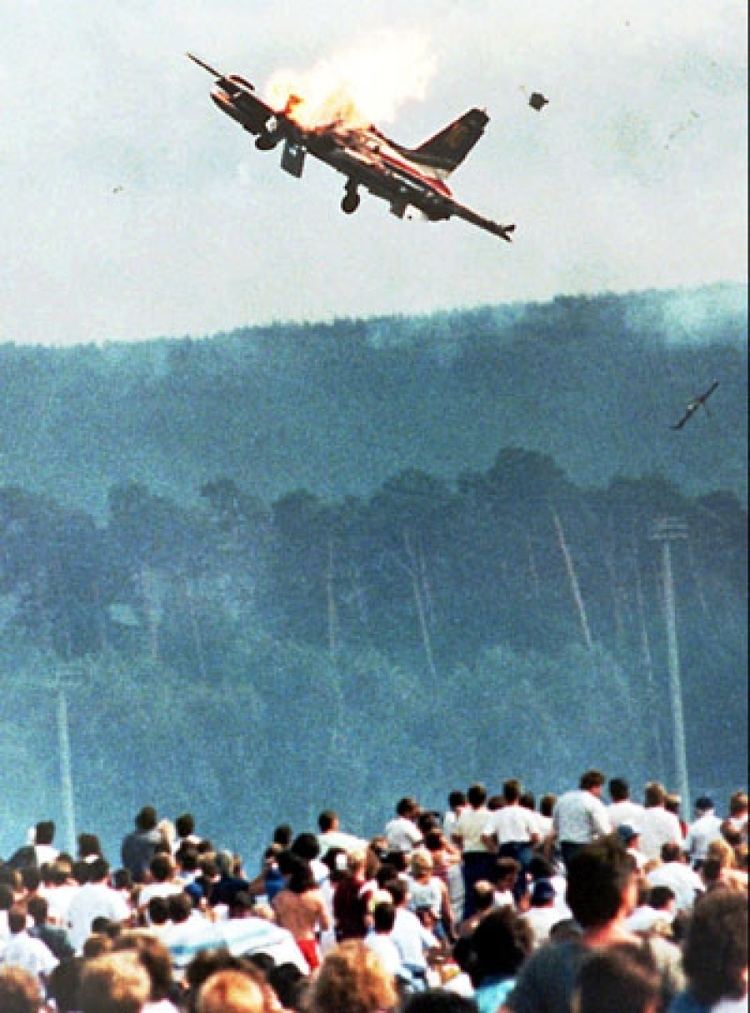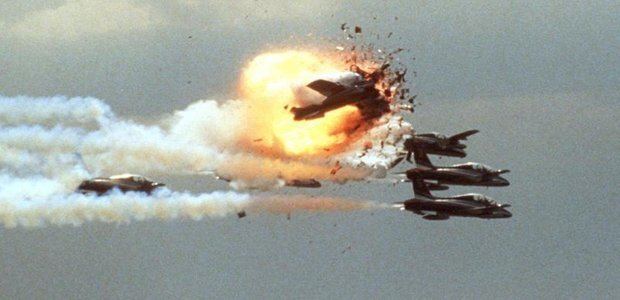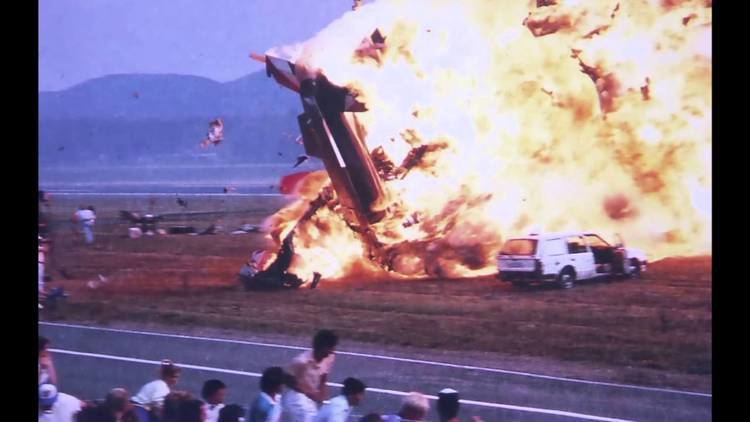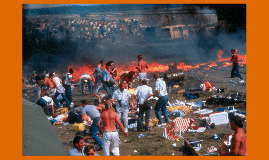Type Aermacchi MB-339PAN Type Aermacchi MB-339PAN | Date 28 August 1988 | |
 | ||
Site Ramstein Air BaseRhineland-PalatinateWest Germany Total injuries (non-fatal) Approximately 1,000, 346 serious (ground) Crew Lt. Col. Ivo Nutarelli (killed) Location Ramstein-Miesenbach, Germany Total fatalities 70 (including 67 on the ground) Similar Sknyliv air show disaster, Avianca Flight 410, 2011 Reno Air Races crash | ||
The Ramstein air show disaster occurred on Sunday, 28 August 1988 during the Flugtag '88 airshow at the US Ramstein Air Base near the city of Kaiserslautern, West Germany.
Contents

Aircraft of the Italian Air Force display team collided during their display, crashing to the ground in front of a crowd of about 300,000 people. There were 70 fatalities (67 spectators and 3 pilots); 346 spectators sustained serious injuries in the resulting explosion and fire, and hundreds more had minor injuries. At the Time it was the deadliest air show accident (until overtaken in 2002 by the Sknyliv air show disaster).

Background

Ten Aermacchi MB-339 PAN jets from the Italian Air Force display team, Frecce Tricolori, were performing their "pierced heart" (Italian: Cardioide, German: Durchstoßenes Herz) formation. In this formation, two groups of aircraft create a heart shape in front of the audience along the runway. In the completion of the lower tip of the heart, the two groups pass each other parallel to the runway. The heart is then pierced, in the direction of the audience, by a lone aircraft.
The crash

The Mid-air collision took place as the two heart-forming groups passed each other and the heart-piercing aircraft hit them. The piercing aircraft crashed onto the runway and consequently both the fuselage and resulting fireball of aviation fuel tumbled into the spectator area, hitting the crowd and coming to rest against a refrigerated trailer being used to dispense ice cream to the various vendor booths in the area.

At the same time, one of the damaged aircraft from the heart-forming group crashed into the emergency medical evacuation UH-60 Black Hawk helicopter, injuring the helicopter's pilot, Captain Kim Strader. He died weeks later, on Saturday, 17 September 1988, at Brooke Army Medical Center in Texas from burns he suffered in the accident.

The pilot of the aircraft that hit the helicopter ejected, but was killed as he hit the runway before his parachute opened. The third aircraft disintegrated in the collision and parts of it were strewn along the runway.
After the crash, the remaining aircraft regrouped and landed at Sembach Air Base.
Scope
Of the 31 people who died at the scene, 28 had been hit by debris in the form of airplane parts, concertina wire, and items on the ground. Sixteen of the fatalities occurred in the days and weeks after the disaster due to severe burns; the last was the burned and injured helicopter pilot. About 500 people had to seek hospital treatment following the event, and over 600 people reported to the clinic that afternoon to donate blood.
Critiques
The disaster revealed serious shortcomings in the handling of large-scale medical emergencies by German civil and American military authorities. US military personnel did not immediately allow German ambulances onto the base, and the rescue work was generally hampered by a lack of efficiency and coordination. The rescue coordination center in Kaiserslautern was unaware of the disaster's scale as much as an hour after it occurred, even though several German medevac helicopters and ambulances had already arrived on site and left with patients. American helicopters and ambulances provided the quickest and largest means of evacuating burn victims, but lacked sufficient capacities for treating them, or had difficulty finding them. Further confusion was added by the American military's using different standards for intravenous catheters from German paramedics. (A single standard was codified in 1995 and updated with a newer version in 2013).
Actions
A crisis counseling center was immediately established at the nearby Southside Base Chapel and remained open throughout the week. Base mental health professionals provided group and individual counseling in the following weeks, and they surveyed the response workers two months following the tragedy and again six months after the disaster to gauge recovery.
Investigation
Several different video recordings of the accident were taped. They show that the "piercing" aircraft (Pony 10) came in too low and too fast at the crossing point with the other two groups (five aircraft on the left and four on the right) as they completed the heart-shaped figure. Lead pilot Lieutenant Colonel Ivo Nutarelli, flying Pony 10, was unable to correct his altitude or lower his speed, and collided with the leading airplane (Pony 1, piloted by Lt. Col. Mario Naldini) of the left formation "inside" the figure, destroying the plane's tail section with the front of his aircraft. Pony 1 then spiralled out of control, hitting the plane on its lower left (Pony 2, piloted by Captain Giorgio Alessio). Lt. Col. Naldini ejected but was killed as he hit the runway before his parachute opened. His plane crashed onto a taxiway near the runway, destroying a medevac helicopter and fatally injuring its pilot, Captain Kim Strader. Pony 2, the third plane involved in the disaster, was severely damaged from the impact with Pony 1, and crashed beside the runway, exploding in a fireball. Its pilot, Captain Alessio, died instantly.
Pony 10, the aircraft that started the crash, continued on a ballistic trajectory across the runway, completely out of control and in flames, its forward section destroyed by the impact with Pony 1. The plane hit the ground ahead of the spectator stands, exploding in a fireball and destroying a police vehicle parked inside the concertina-wire fence that defined the active runway area. The plane continued, cartwheeling for a distance before picking up the three-strand concertina-wire fence, crossing an emergency access road, slamming into the crowd, and hitting a parked ice cream van. The area of the crash, being centered on the flightline and as close to the airshow as civilian spectators could get, had been considered the "best seats in the house", and was densely packed. The entire incident, from the collision of the first two planes to the crash into the crowd, took less than seven seconds, leaving almost no time for spectators to run away. The low altitude of the maneuver (45 meters above the crowd) also contributed to the short time frame.
An examination of photos and footage from the disaster showed that Pony 10's landing gear came down at some point; it has been suggested that this could have been lowered intentionally as a last second effort by Lt. Col. Nutarelli to slow his plane down and avoid the impact, but there is no substantial evidence pointing to this; the undercarriage could have been lowered by a number of factors. In January 1991, Werner Reith, a German journalist from the newspaper Tageszeitung, suggested in an article that the Ramstein disaster could have been caused by some sudden technical problem—or even sabotage—in Nutarelli's plane. No supporting evidence could be collected. Reith pointed out that Lt. Col. Nutarelli and Lt. Col. Naldini were supposed to know details about another air disaster, the 1980 Ustica Massacre, citing Italian press sources. Judge Rosario Priore, who was investigating the case at the time, found that they were performing training flights nearby minutes before the Ustica incident, but he definitely rejected their deaths as sabotage.
